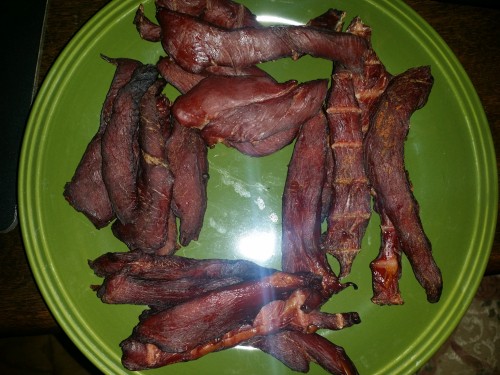Homemade Venison Jerky Instructions & Recipes
I have processed my own deer meat this year and made some venison jerky. One entire deer was made into four different varieties of jerky. I made up the recipes myself. Here are the details:
I first cut the deer meat off the bones. Cut off all the fat and sinew that you can. Cut the meat into strips along the grain of the muscle. Thin 1/2 inch strips of meat work best for jerky. You can, of course, use beef instead of venison if you prefer. The strips of meat should be about 4 to 6 inches long for best results. It is easier to keep the meat from falling through the grates of the smoker if the meat strips are longer. But you can use any size you choose. I used all the scraps as well and the jerky turned out perfect.

Next you can choose one of the recipes below or use your own favorite venison jerky recipe. Each recipe is best with about 2 to 3 pounds of meat. Adjust ingredients as needed for larger quantities of meat. You will need some containers with lids that are large enough to cover hold the meat. With each recipe, make sure that the meat is fully submerged in the sauces or water for best results and full flavor throughout.
Recipe 1 - Soy Flavored
1 cup worcestershire sauce
1 cup soy sauce
1 tablespoon crushed peppercorns
1 tablespoon onion powder
1 tablespoon garlic powder
Feedback from taste testers - everyone who tried this flavor really liked it and had no complaints at all. This one tastes very good. The soy and worcestershire sauce also tenderized the meat, making it easy to chew.
Recipe 2 - Salt & Pepper Flavored
1 tablespoon onion powder
1 tablespoon garlic powder
1 tablespoon crushed peppercorns
3 tablespoons of salt
Taste testers said this was the very best flavor of them all. This one has full flavor and a good, salty taste. My friends said they would not change a thing in this recipe. For some people this one may have a bit high sodium content though so for low sodium diets you may want to reduce the salt a bit. The salt makes it perfect for long term preservation though.
Recipe 3 - Cajun Flavored
Cajun seasoning salt
Water
For this recipe I simply used cajun seasoning salt and water to cover the meat. I put in a layer of meat and covered it with seasoning. Then another layer of meat and more seasoning until all the meat was used up. Finally I covered the meat with more seasoning and then water to cover all the meat. I poured the water into the side of the container to avoid washing off the meat on top. This recipe would be better with more salt and some of your favorite hot sauce. Taste testers said it was a bit bland. I will experiment with this recipe and update it later.
Recipe 4 - Terriyaki Flavored
1 bottle, 16 ounces of Pineapple Terriyaki sauce.
This version let the natural smoke flavor come though nicely. Everyone commented on the smokiness of the jerky. The sauce tenderized the meat nicely, making it very easy to chew. This would be a good sauce for tougher cuts of meat. The terriyaki flavor is not overpowering or very strong though. I would say it turned out quite mild.
Smoking Instructions
Marinate the meat in a cool place overnight. I waited until the weather was colder to make mine outside. I put it out in a shaded place to marinate for 30 hours. If you have a refridgerator this is perfect. But you do not want the meat to freeze or the flavor will not be able to work itself through the meat.
After marinating the meat, I placed it on smoker racks for a few hours to drip off. This lets the excess juices run off the meat so that in the smoker the flavors will not mix. This step is not necessary but I wanted to be sure my flavors would be pure.
While the meat was dripping off, I fired up the charcoal smoker and let it burn until the coal was burning evenly.
I placed the meat on the racks evenly spaced with no pieces touching another. If the meat touches another, it will not dry as well.
I smoked the meat a full 24 hours at a range between 120 to 150 degrees.
The next day, I placed the meat on cookie sheets and on top of my tiny house wood stove to finish drying and to pasteurize it to be safe. You can place yours in the oven at 150 degrees for ten minutes. This step is simply to ensure that the meat is pasteurized and safe to eat.
I put my venison jerky into zipper bags and labeled them. Then I put the jerky into my freezer for storage. You could keep yours in the fridge for immediate eating or in the freezer for later use.
Enjoy.
You can see the videos of my venison jerky making process in the following links. Note that I changed the recipes a bit after my first try.
Processing Deer Meat Jerky & Mixed Off Grid Homestead Work
Making Venison Jerky At The Off Grid Homestead
Homemade Venison Jerky & Recipes Shared
About the Author
| Troy Reid |



